Yelden Church Alterations and Additions

The church from the south March 2014
Most of the structural history of the church can be found in detail in Bedfordshire Historical Record Society Volume number 79 of 2000 Bedfordshire Churches in the Nineteenth Century: Part III: Parishes S to Y put together by former County Archivist Chris Pickford from numerous sources some held by Bedfordshire & Luton Archives & Records Service and some held elsewhere or published.
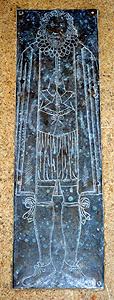
Close-up of the brass of Christopher Strickland March 2014
The bells date from 1610, 1617, 1660 and 1717 respectively. The communion table has the initials CS carved on it, which may stand for Christopher Strickland who died in 1628 and whose brass survives in the church.
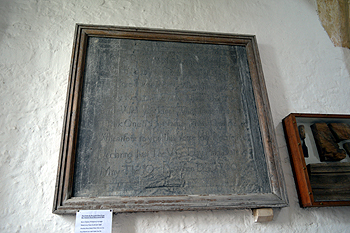
Poem on a lead sheet March 2014
In the tower is a verse written on a piece of lead. This was taken from the roof in 1892 and is dated 1703. It is by Thomas Williamson and reads as follows:
"Here Thomas Williamson I do Right
Which is my name in all mens sight
Tharfore Dear frinds When This you See
Pray Reead it ore And Think One Me
And When you Hear that I am Dead
Think One My name That One the led
Wherefore to you this Verse I do Relate
Declaring iust The Very Day and Date
May the 19 Day Ano Dom 17.03"
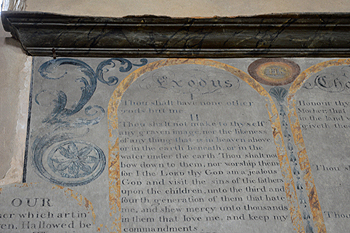
Ten Commandments wall painting detail March 2014
The Ten Commandments, Creed and Lord's Prayer are all painted on the north wall of the nave. They also probably date from the 18th century. The church once had box pews in nave and aisles and they are likely to have been installed around this time.
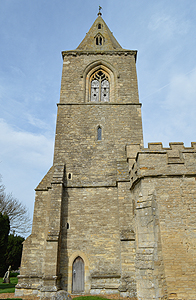
The south face of the west tower March 2014
The tower was repaired in 1843 and in 1847 as recorded in vestry minutes [P119/8/1]. Estimates were also received for replacing the roof leads.
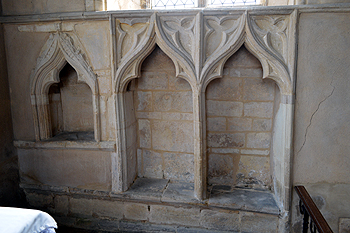
Piscina and sedilia March 2014
John Martin was librarian at Woburn Abbey. He was pompous, opinionated and often highly vituperative in his articles on Bedfordshire churches in the Northampton Mercury in the middle of the 19th century. Yelden escapes the complete condemnation of the church at Melchbourne but still comes in for its share of criticism. The article was published on 30th October 1852, the week after Melchbourne: "The chancel has an open roof; sedilia and other decorations sadly mutilated. The two old crazy seats which are in this part of the church, old and decayed indeed, are far preferable to the huge boxes generally placed here. The pavement, though much worn, is kept clean. Two brasses here, one of the early date of 1433 [John Heyne, Rector]. In the vestry is deposited the old oak chest, forming a remarkable contrast to the modern one".

The nave roof March 2014
"The nave and aisle preserve their timber roofs. There are some original open benches; but for those who must occupy exclusive and enclosed sittings, a portion of the open seats have been used, by adding timbre above, and clapping on doors".
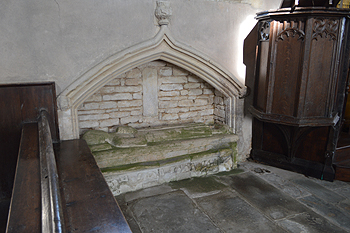
Tomb recess and effigy in the north wall of the nave March 2014
"To make room for enclosed sittings, here, as elsewhere, little regard is paid to ancient monuments or decorations if they stand in the way on the ignorant village carpenter employed in their erection. In this instance a recumbent figure has been sadly mutilated by the wooden work surrounding it. We would fain have attributed this demolition to the Puritans, whose wrath was kindled by a sermon of the rector's, in the year 1640, and ordered by Parliament to be publicly burnt [John Pocklington, rector, was deprived of the living in 1641 and died soon after]; but it bears too evident marks of a later period. "Diuturnity is a dream and folly of expectation".
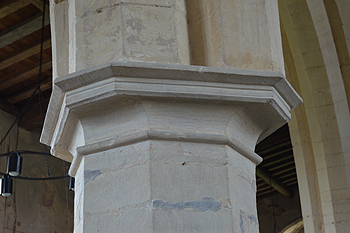
Capital in the south arcade March 2014
"This is a very small church; but two stoves are employed in warming it. On a small platform is a musical instrument, in what name it rejoices we are ignorant; whatever its tones may be to the ear, it is not agreeable to the eye. Whitewash, as usual, is copiously used, two brackets, supporting arches, were almost indistinguishable".
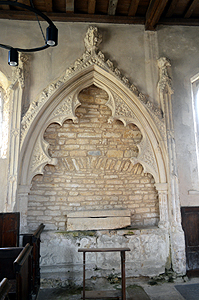
14th century tomb recess in the south aisle March 2014
"In the aisle the canopy of a monument is sadly be-plastered; and its lower part, by a wooden work of some pews ruthlessly brought in to hasten its destruction. A piscina is obscured by some planks in a state of decay, despite the two stoves; a cherub, over a beautiful bracket, seemed to deplore the surrounding devastation".
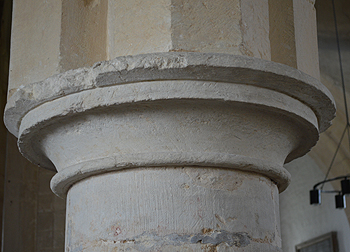
A capital in the south arcade March 2014
"The columns appear to be painted, thus preserving the dresses of the occupants from the visitation of whitewash, most generally used. Yet two appear to have been purified from the plaster or paint to which they had once been subjected – an atonement perhaps for the injuries elsewhere inflicted".
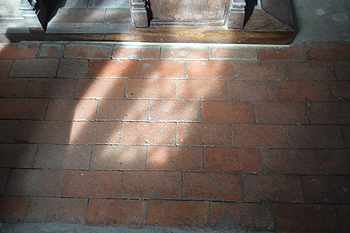
Brick floor in the south aisle March 2014
"The paving is in a disgraceful condition. The font has been scraped, but, although it has lead lining and drain, it is not used".

The interior looking west March 2014
"A sort of squint is constructed in the wooden work, shutting out the belfry arch, which we believe is used as a mode of communication from the bell-ringers, to him who presides over the interior music".
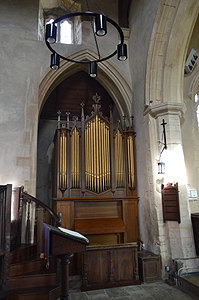
The organ March 2014
A new organ was placed in the church in 1865. It was rebuilt in 1892 when it was removed to its current home, the specially built organ chamber [P119/8/1 and P119/2/2/1-2] when the chancel was repaired at the expense of the Rector. A clock was placed in the tower in 1876.

Jesus teaching - south chancel window March 2014
The stained glass window in the chancel is in memory of Rev John Fernie. He died in 1870. The tower and spire were restored in 1882 [P119/1/1/ and P119/8/1], the bells were re-hung in a new frame four years later [P119/1/1] and the weathercock added to the spire in 1896.
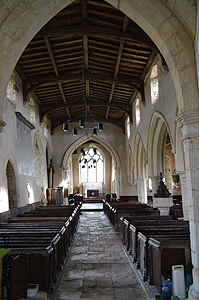
The interior looking east March 2014
In 1906 gales damaged the nave roof necessitating its repair [P119/1/1]. In 1934 the tower and spire were repaired. Further repairs were made between 1985 and 1993.